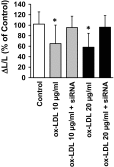Physiological and therapeutic regulation of PCSK9 activity in cardiovascular disease
- PMID: 28439730
- PMCID: PMC5403857
- DOI: 10.1007/s00395-017-0619-0
Physiological and therapeutic regulation of PCSK9 activity in cardiovascular disease
Abstract
Ischemic heart disease is the main cause of death worldwide and is accelerated by increased levels of low-density lipoprotein cholesterol (LDL-C). Proprotein convertase subtilisin/kexin type 9 (PCSK9) is a potent circulating regulator of LDL-C through its ability to induce degradation of the LDL receptor (LDLR) in the lysosome of hepatocytes. Only in the last few years, a number of breakthroughs in the understanding of PCSK9 biology have been reported illustrating how PCSK9 activity is tightly regulated at several levels by factors influencing its transcription, secretion, or by extracellular inactivation and clearance. Two humanized antibodies directed against the LDLR-binding site in PCSK9 received approval by the European and US authorities and additional PCSK9 directed therapeutics are climbing up the phases of clinical trials. The first outcome data of the PCSK9 inhibitor evolocumab reported a significant reduction in the composite endpoint (cardiovascular death, myocardial infarction, or stroke) and further outcome data are awaited. Meanwhile, it became evident that PCSK9 has (patho)physiological roles in several cardiovascular cells. In this review, we summarize and discuss the recent biological and clinical data on PCSK9, the regulation of PCSK9, its extra-hepatic activities focusing on cardiovascular cells, molecular concepts to target PCSK9, and finally briefly summarize the data of recent clinical studies.
Keywords: LDL; LDL receptor; oxLDL.
Conflict of interest statement
Authors received honoraria from Amgen (R.S., K.D.S, U.L.), Astra Zeneca (R.S.), MSD (U.L.), Recordati (R.S.), and Sanofi (R.S., U.L.) for lecturing.
Figures




Similar articles
-
PCSK9 targets important for lipid metabolism.Clin Res Cardiol Suppl. 2017 Mar;12(Suppl 1):2-11. doi: 10.1007/s11789-017-0085-0. Clin Res Cardiol Suppl. 2017. PMID: 28176216 Free PMC article. Review.
-
PCSK9: from biology to clinical applications.Pathology. 2019 Feb;51(2):177-183. doi: 10.1016/j.pathol.2018.10.012. Epub 2018 Dec 4. Pathology. 2019. PMID: 30522786 Review.
-
Proprotein convertase subtilisin/kexin type 9 (PCSK9) inhibitors: Present perspectives and future horizons.Nutr Metab Cardiovasc Dis. 2016 Oct;26(10):853-62. doi: 10.1016/j.numecd.2016.05.006. Epub 2016 May 30. Nutr Metab Cardiovasc Dis. 2016. PMID: 27352986 Review.
-
Proprotein Convertase Subtilisin/Kexin-Type 9 and Lipid Metabolism.Adv Exp Med Biol. 2020;1276:137-156. doi: 10.1007/978-981-15-6082-8_9. Adv Exp Med Biol. 2020. PMID: 32705598 Review.
-
Targeting the proprotein convertase subtilisin/kexin type 9 for the treatment of dyslipidemia and atherosclerosis.J Am Coll Cardiol. 2013 Oct 15;62(16):1401-8. doi: 10.1016/j.jacc.2013.07.056. Epub 2013 Aug 21. J Am Coll Cardiol. 2013. PMID: 23973703 Review.
Cited by
-
Therapeutic effect of nanoliposomal PCSK9 vaccine in a mouse model of atherosclerosis.BMC Med. 2019 Dec 10;17(1):223. doi: 10.1186/s12916-019-1457-8. BMC Med. 2019. Retraction in: BMC Med. 2023 May 4;21(1):166. doi: 10.1186/s12916-023-02884-w. PMID: 31818299 Free PMC article. Retracted.
-
Proprotein Convertase Subtilisin/Kexin 9 as a Modifier of Lipid Metabolism in Atherosclerosis.Biomedicines. 2023 Feb 9;11(2):503. doi: 10.3390/biomedicines11020503. Biomedicines. 2023. PMID: 36831039 Free PMC article. Review.
-
Response: Serum Levels of PCSK9 Are Associated with Coronary Angiographic Severity in Patients with Acute Coronary Syndrome (Diabetes Metab J 2018;42:207-14).Diabetes Metab J. 2018 Aug;42(4):350-352. doi: 10.4093/dmj.2018.0138. Diabetes Metab J. 2018. PMID: 30136454 Free PMC article. No abstract available.
-
Effect of Parathyroidectomy on Metabolic Homeostasis in Primary Hyperparathyroidism.J Clin Med. 2022 Mar 2;11(5):1373. doi: 10.3390/jcm11051373. J Clin Med. 2022. PMID: 35268464 Free PMC article.
-
PCSK9: A Multi-Faceted Protein That Is Involved in Cardiovascular Biology.Biomedicines. 2021 Jul 8;9(7):793. doi: 10.3390/biomedicines9070793. Biomedicines. 2021. PMID: 34356856 Free PMC article. Review.
References
-
- Abifadel M, Varret M, Rabes JP, Allard D, Ouguerram K, Devillers M, Cruaud C, Benjannet S, Wickham L, Erlich D, Derre A, Villeger L, Farnier M, Beucler I, Bruckert E, Chambaz J, Chanu B, Lecerf JM, Luc G, Moulin P, Weissenbach J, Prat A, Krempf M, Junien C, Seidah NG, Boileau C. Mutations in PCSK9 cause autosomal dominant hypercholesterolemia. Nat Genet. 2003;34:154–156. doi: 10.1038/ng1161. - DOI - PubMed
-
- Adorni MP, Cipollari E, Favari E, Zanotti I, Zimetti F, Corsini A, Ricci C, Bernini F, Ferri N. Inhibitory effect of PCSK9 on Abca1 protein expression and cholesterol efflux in macrophages. Atherosclerosis. 2017 - PubMed
-
- Al-Mashhadi RH, Sorensen CB, Kragh PM, Christoffersen C, Mortensen MB, Tolbod LP, Thim T, Du Y, Li J, Liu Y, Moldt B, Schmidt M, Vajta G, Larsen T, Purup S, Bolund L, Nielsen LB, Callesen H, Falk E, Mikkelsen JG, Bentzon JF. Familial hypercholesterolemia and atherosclerosis in cloned minipigs created by DNA transposition of a human PCSK9 gain-of-function mutant. Sci Transl Med. 2013;5:166ra1. doi: 10.1126/scitranslmed.3004853. - DOI - PubMed
Publication types
MeSH terms
Substances
LinkOut - more resources
Full Text Sources
Other Literature Sources
Miscellaneous

